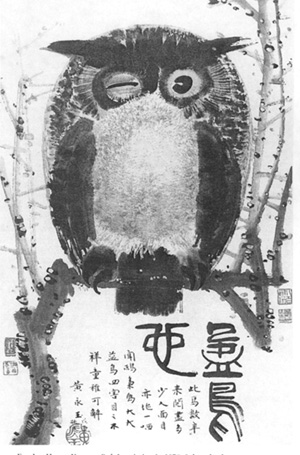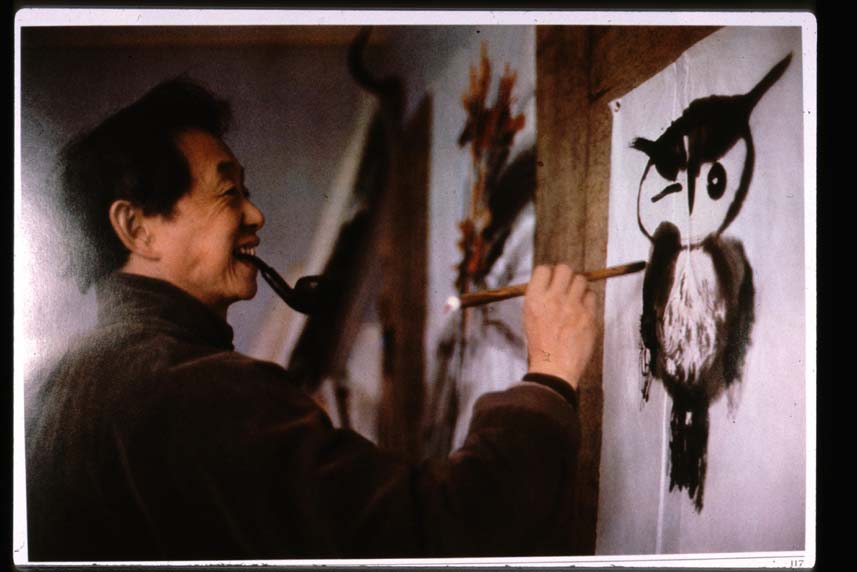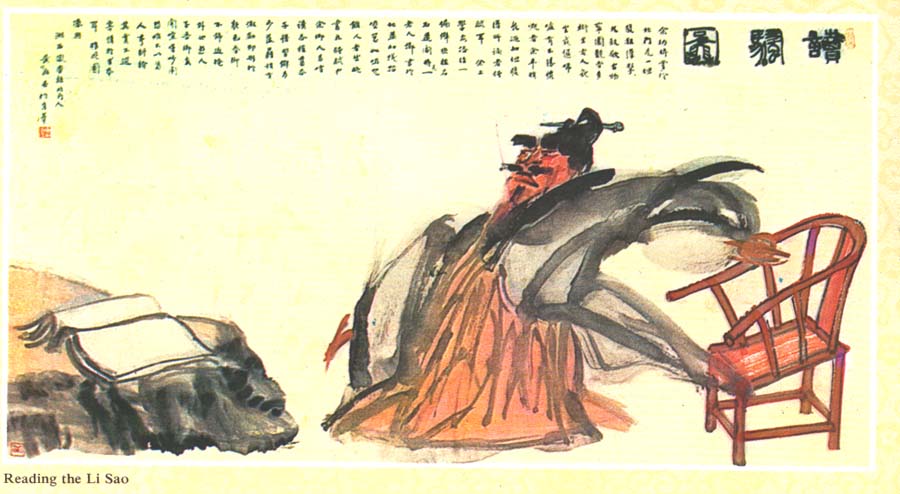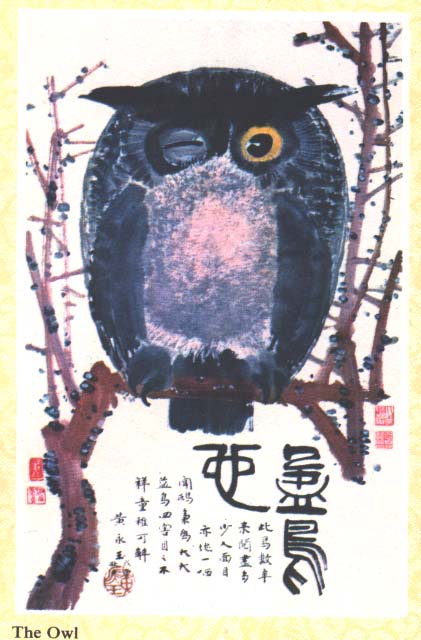The Great Proletarian Cultural Revolution
...an impossibly large subject to take on, but Wikipedia's article is a fine summary and a good place to begin.
Since the Cultural Revolution figures prominently in both To Live and A Breath, I thought I'd try a different tack, and at the same time exemplify for you the kind of thing I hope your projects will evolve into.
I happened to know one of those 'ears-of-hippopotamus' tales that provides entrée into the grander Epic, having to do with an artist (a close friend of Huang Miaoze) who ran afoul of the shifting sands of the politics of Cultural Revolution, so I went hunting for more information with a google search for "winking owl". That led me to a book that turned out to be in Leyburn (Laing's The Winking Owl: Art in the People's Republic of China [FOLIO N7345 .L35 1988]), and also led me to an article by Eugene Wang: "The Winking Owl: Visual Effect and Its Art Historical Thick Description" Critical Inquiry 26 (Spring 2000), pp. 435-73 --which I retrieved in Leyburn. These materials provided me with what I needed to start telling the tale.
Consider this image:

Huang Yongyu produced this Owl in 1973.
The owl, with its one eye open and the other closed,
is a self-portrait of the likes of Huang. It reveals their attitude:
an animosity toward the Proletarian Cultural Revolution and the Socialist system.
(from "Castigation of the Black Paintings", quoted in Wang 2000:435)
There is a consensus now that the painter was a victim more sinned against than sinning, that he became an innocent pawn in a game of high-level power politics, and that the inquisition to which the painter and his painting were subjected made a travesty of art criticism. It is not clear, however, how innocent the painting was. Does the painting contain the message it was charged with? (Wang 2000:438)
It has generally been assumed that the subjects of the maligned Hotel School paintings were totally innocent, devoid of political significance. This assumption, however, might be naive.
Painted for a friend, Huang Yongyu's Winking Owl, it was claimed by his detractors, scoffs at socialism. But the implied political criticism is more acute than this. Although it was not mentioned in the published materials on Huang, the owl in Chinese popular lore and tradition is an ominous bird: "The voice of the owl is universally heard with dread, being regarded as the harbinger of death." ...As a creature of darkness and ill omen, its power begins on the summer solstice, the day of the sun's greatest strength but also the day the sun begins to wane. The ominous connotations of the owl and the symbolic association that might be made between Mao's waning years and Jiang Qing's waxing political power surely figured in the castigation of this painting and its maker. Further, Huang Yongyu had earlier (1962) gotten into trouble for his "counterrevolutionary" Animal Crackers poems in which he used animals to lampoon political figures. (Laing 1988:86)
There is no denying that Owl has a communicative efficacy that is derived, among other things, from the owl's enigmatic facial expression. There are two ways of characterizing it: one can see it either as a one-eye-open stare or as a wink. Either way is associated with a set of moods and entails one particular interpretation at odds with the other. The stare connotes distrust and hostility; the wink connotes trust and secret-sharing. Huang's persecutors held to the former interpretation, which chimes with a familiar Chinese phrase, "keeping one eye open and the other closed." The saying describes a sneering aloofness or a resigned stance pretending not to see what is essentially an undesirable situation. Once the visual form is reduced to a discursive proposition, it is easy to attach an interpretation to it. (Wang 2000:454)
Since the late 1950s, the owl's moral character as an agent of dark unknown forces has been recast. In these years, as China experienced drought and famine, it was necessary to do whatever possible to stop voracious sparrows and mice from competing with the starving humans. Nationwide campaigns were launched to kill these destructive birds and rodents. Accordingly owls, the natural enemy of these malevolent creatures, were highly appreciated as "beneficial birds" diligently preying on mice and sparrows. With the ingrained Chinese cultural aversion to the bird, however, the owl was a hard sell. Its apologists had a lot of explaining to do, and they did this in campaign style. Children's books were written in which owls were described as loveable heroes dutifully guarding the crop fields against marauding medleys of rats and sparrows. The campaigners even made an educational film featuring owls as the protagonists... The owl's public image was improved, at least among the generation that grew up with the picture books featuring owl heroes. Huang was an active illustrator of children's books, so it is likely that he would have known of these campaigns. Upon his post-Mao exoneration, Huang repainted a number of variations of the 1973 Owl with the inscription: "This is a benevolent bird." (Wang 2000:444-445)

(I followed up on a couple of things: found a reference to the Animal Crackers collection in the Laing book [which I'd found via a google search for "winking owl", and then found that we had, via Annie], and asked Annie if we had it... we did [Beijing Street Voices: the poetry and politics of China's Democracy Movement, PL2658 .E3 G58], and the poems turn out to be pretty cool... and the intro material pointed to an artice on Huang Yongyu in the July [actually August...] 1979 issue of China Reconstructs, which I found that we had on LL1. In that source I found this passage:
Reading the Li Sao is another work treating the subject of Qu Yuan [340-278 BC: a famous tragic figure in Chinese literature --the Li Sao can be found at PL2661 .A27 1980]. Remembering scenes from his childhood, Huang Yongyu comments on the passionate differences of opinion in his village over the tragedy of Qu Yuan's exile and the pain and despair that drove him to take his life for having been unjustly accused by his sovereign --differences that lead the villagers to emotional reactions of great agitation and violence. The portrait is of a man with thick eyebrows and two straight moustaches seated on the ground, his hair done up and held by a long green pin. Next to him a red chair stands out in the composition against the prevalence of dull grey and yellow. In overwhelming despair for the poet, the man has put the Li Sao down.

At the bottom on the left is a small seal: an owl with one eye closed --and this needs an explanation.It was thanks to an owl that Huang Yongyu won a high place in an exhibition of "black painters" thought up by Jiang Qing (Chiang Ching) and held in the National Art Gallery in Beijing in 1974. He had painted this bird for a friend. It had one eye shut. Someone said that this eye was closed to socialism and the cultural revolution. The superficiality and crudeness of such a pretext for condemning one of the most prominent painters of China, together with many others, needs no comment. The famous "prize" owl has been lost, but the artist has painted many others since, with the same mastery, the same imaginative fantasy, the same flooding humor.
This is why, prominently displayed in the first great hall of the exhibition, is The Owl. The painting represents a big, fat bird in white and brown tones on a dark branch spotted with moss-green. Of course, it has a closed eye. The other one, of a fine saffron yellow, is round and open like a daisy. "It's a Good Bird" say three large characters. Lower down, the inscription concludes the painting with its own sarcasm: "It's a joke that even this bird has seen through many people over the last few years. It is said that the owl is a very beneficial bird. The gang of four regarded it as evil --but even children know better."
(China Reconstructs August 1979:44)
...and here's the Owl in color:

See also Morning Sun 'Can of Worms' ("a collection of aphorisms and witty lines that Huang distributed among his friends; some of the writings made humorous use of Party jargon. In the summer of 1966, these private writings were declared to be counter-revolutionary. Huang was criticized, denounced in public meetings, and severely beaten.")
This is as far as I've gone in several hours of searching, reading, transcribing, scanning... but it's just the sort of thing I'd like you to be doing. I've worked from quotations, but I stress that they're just the beginning: they're what I'd use as elements of the eventual project, if I was doing one on the arts of the Cultural Revolution).



